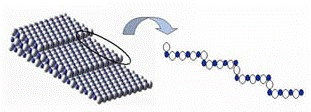Department of Chemistry
Document Type
Article
Date of this Version
May 1999
Abstract
The surface and bulk compositions of the mixed metal oxide CoxNi1-xO have been compared over the entire range of stoichiometry 0 ≤ x ≤ 1. The materials, which were formed as polycrystalline solid solutions, were shown to be well-ordered and homogeneous in the bulk, but tend to deviate in their surface composition for x > 0.6. Auger and X-ray photoelectron spectroscopy gave comparable results and indicated that the surface composition for samples showing deviation from bulk stoichiometry was compatible with the formation of a spinel-like NiCo2O4 surface phase. XPS binding energies and spectral peak shapes provided information that indicates that the Ni2+ cations occupy octahedral sites, leaving the Co3+ divided between tetrahedral and octahedral occupancy in an inverse spinel structure. The surface spinel shows evidence of oxide defect formation, however, and in the range of the spinel formation yields a second O 1s peak with binding energy of 531.2 eV that cannot easily be attributed to hydroxyl formation. The oxygen species, which has been reported previously for surface oxidation to produce similar metal oxide compounds, has been attributed to defect lattice oxygen.



Comments
Published in Applied Surface Science 147:1-4 (May 1999), pp. 58-66. doi:10.1016/S0169-4332(99)00077-X Copyright © 1999 Elsevier Science B.V. Used by permisssion. http://www.sciencedirect.com/science/journal/01694332